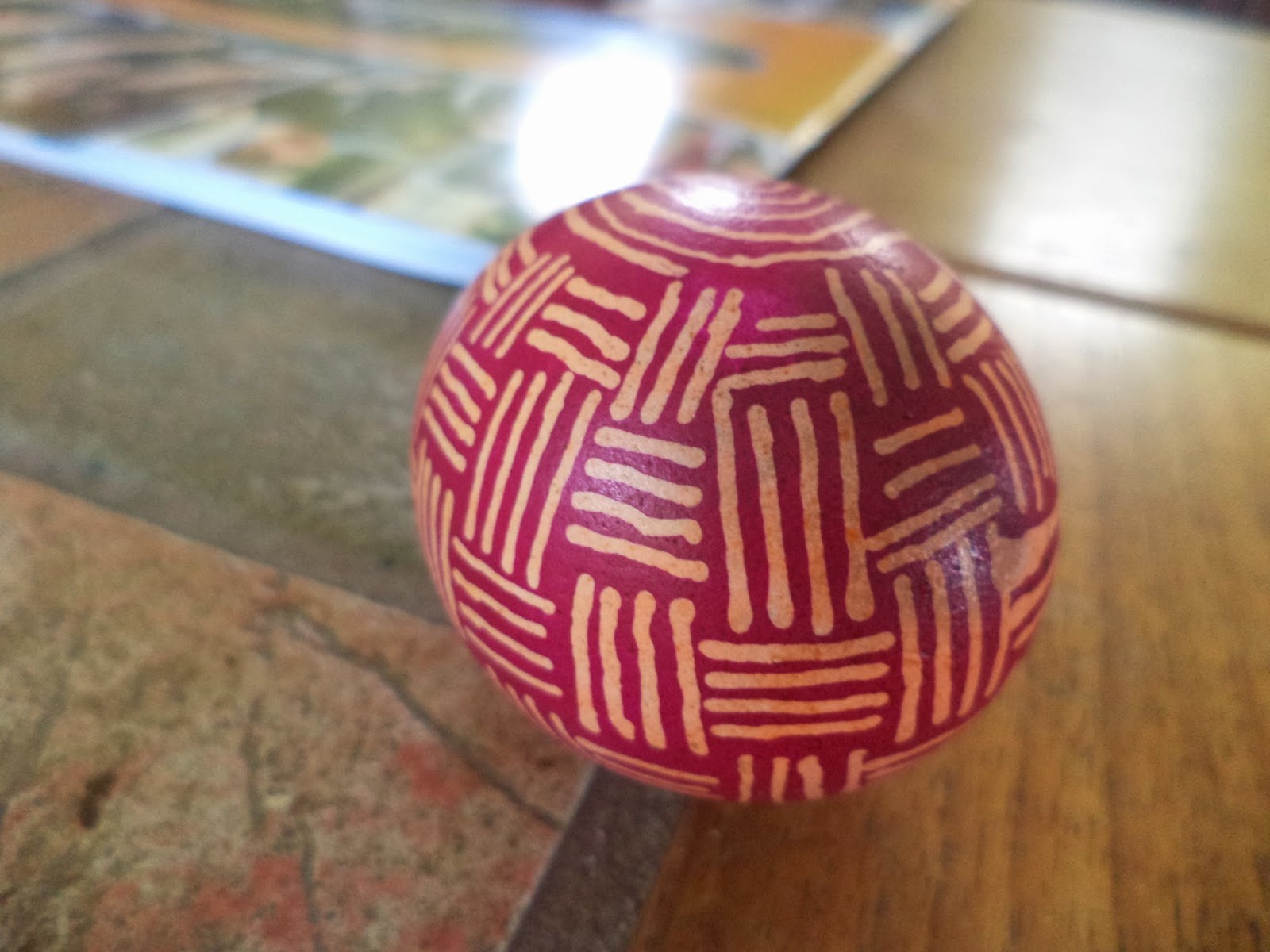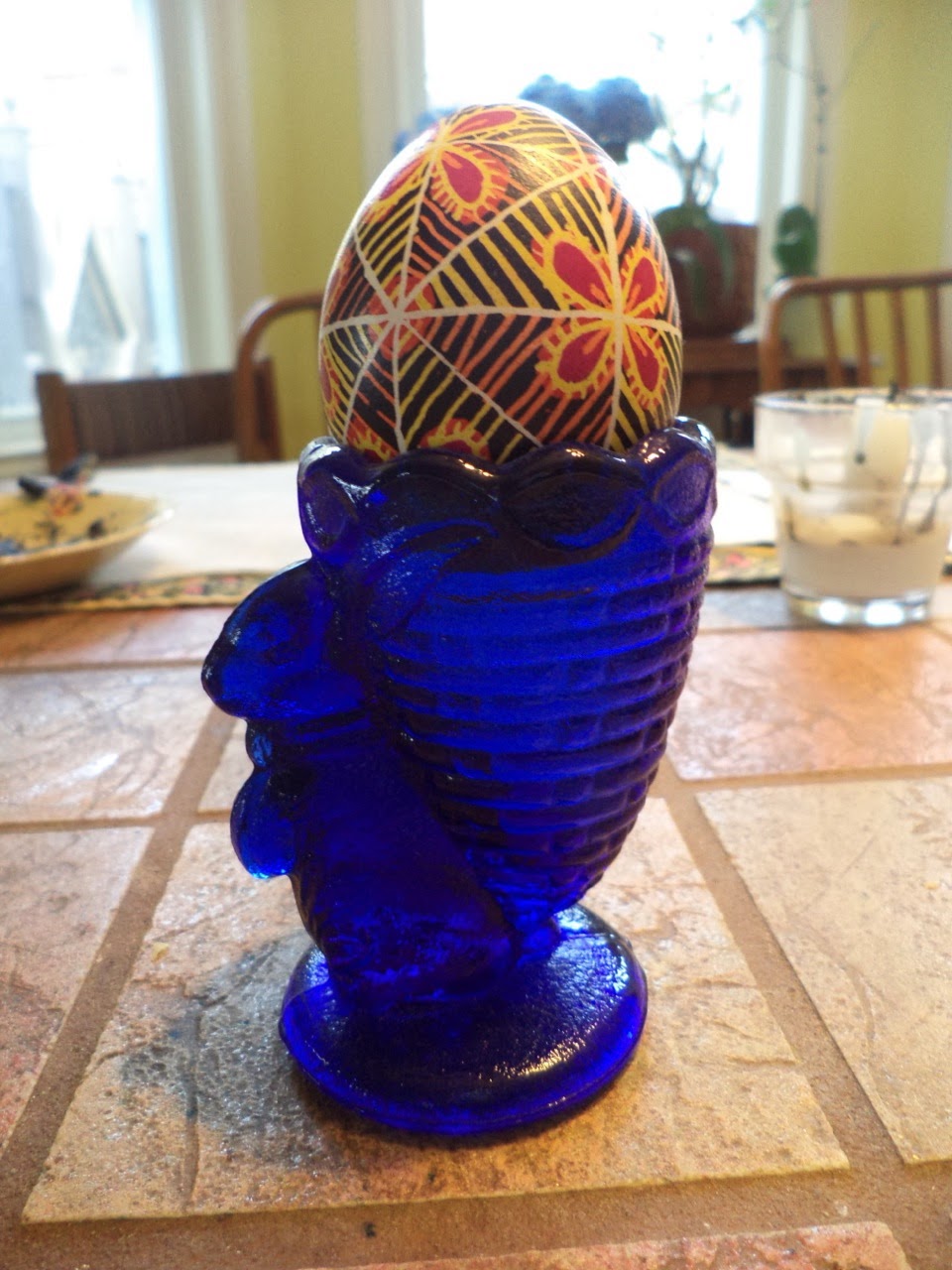It's Good Friday and you know what that means. It means that there will be a full day of prayer - the kids love it! - marking the anniversary of Jesus' death by crucifixion. We will remove all flowers and shiny objects from our home, and we will also fast. :-)
It also means that I will venture downstairs into the cellar and retrieve my supplies to make Ukrainian Easter eggs:
I used to decorate eggs with my family when I was a kid, but we used a kit like this:
When I was really young, I wanted to eat those little tablets up (they looked like candies), but as I grew older and wiser, having surreptitiously sampled one and realizing that THERE WAS NO SUGAR IN IT AT ALL!, I grew to be happy with the chemistry involved in the preparation of the dyes. My brother and I fought over who got to be the one to add the tablespoonful of vinegar to the tablet to make it fizzzzzzzzzzzzzzzzzzzzzzzzzzz like mad.
My Mom's side of the family is Ukrainian, but no one in our family decorated eggs in the old style. My Nana made perogies, which she called petta-heh (phonetic spelling here, will someone please tell me how to spell that properly?) and paska (Easter bread) but she didn't make pysanky.
I had always obsessed over the single pysanka in my Nana's china cabinet, but I wasn't allowed to handle it. In addition to the prized egg, the china cabinet housed all sorts of forbidden fruit: my Dido's sizeable calculator "collection" can you say hoarder?, the sour balls, the chocolate bars past their prime, the cribbage board, and the tins full of coins. I wanted to get into that cabinet and I vowed that one day, I would learn how to make an egg like that.
Fast forward, twenty years later. At age 27, while working at the National Library in Ottawa, I saw an advertisement for an egg decorating workshop at the Ukrainian Orthodox Cathedral. Sign me up! I learned this ancient art from a Pysanky master who showed her eggs around the world. I eggsulted over my good fortune. Here's the egg that I made in that workshop:
What a beauty! Clearly, I'm a natural. The children have since broken this egg, the brats. They probably shook it which is a total NO-NO, and which is everyone's immediate reaction when they pick up a pysanka for the first time. Why the hell do you want to shake it, people? You can feel that it's all dried up inside, dammit. DON'T SHAKE THE EGGS!
Rant over, although there will probably be another, if I'm honest.
I took some pictures for those of you who would like to learn how to make your own pysanky. I find egg decorating to be usually very meditative and relaxing except when a child's hair is on fire or another child tries to burn down the library during a workshop that I'm leading, and that is a good thing for someone like me. Here's my set-up at the dining room table, where the magic happens. It looks like my crack smoking kit, but it's not, honest. Pictures of that to come.
The newspaper and paper towel are for hot beeswax spatters, and the red kistka is used to apply the wax to the raw egg. You dip the copper funnel at the tip of the kistka into a candle flame to heat it up. When it's nice and hot, you scoop the funnel into the beeswax and it should go in like a hot knife through butta. The tip of the kistka is applied to the egg and the wax should run freely. Beeswax is used because it has a low melting point (useful for when the wax is removed at the end) and as an added bonus, it smells good:
A closeup of the same egg, right before it's dipped into the yellow dye. The only white on the finished egg is beneath the beeswax. Does this make sense? Once I dip the egg into the yellow dye, all the white that you see here will disappear, reappearing only when I melt the wax off at the end of the process:
My egg has been removed from the yellow dye after about 5 minutes, and I have added more wax to it. These new lines of beeswax will have yellow beneath them.
Dark pink is next:
Then a quick dip into red to brighten the colour:
And finally, the black. Here's the egg right before I begin to melt all that wax:
The wax is removed by holding the egg at the side of a candle flame and wiping off the excess wax on a tissue. You don't hold the egg above the flame because doing so will leave carbon marks like this:
I don't know why the carbon is only at the top of the flame and not at the side. It must rise as it burns off? Help me out, chemists!
Here is my favourite moment. It's like watching a baby being born:
Tada! It's gorge. I think I like my egg better than the one in the book!
The Thrill Kill Kult is for all of you Devil Bunnies out there:
It also means that I will venture downstairs into the cellar and retrieve my supplies to make Ukrainian Easter eggs:
I used to decorate eggs with my family when I was a kid, but we used a kit like this:
When I was really young, I wanted to eat those little tablets up (they looked like candies), but as I grew older and wiser, having surreptitiously sampled one and realizing that THERE WAS NO SUGAR IN IT AT ALL!, I grew to be happy with the chemistry involved in the preparation of the dyes. My brother and I fought over who got to be the one to add the tablespoonful of vinegar to the tablet to make it fizzzzzzzzzzzzzzzzzzzzzzzzzzz like mad.
My Mom's side of the family is Ukrainian, but no one in our family decorated eggs in the old style. My Nana made perogies, which she called petta-heh (phonetic spelling here, will someone please tell me how to spell that properly?) and paska (Easter bread) but she didn't make pysanky.
I had always obsessed over the single pysanka in my Nana's china cabinet, but I wasn't allowed to handle it. In addition to the prized egg, the china cabinet housed all sorts of forbidden fruit: my Dido's sizeable calculator "collection" can you say hoarder?, the sour balls, the chocolate bars past their prime, the cribbage board, and the tins full of coins. I wanted to get into that cabinet and I vowed that one day, I would learn how to make an egg like that.
Fast forward, twenty years later. At age 27, while working at the National Library in Ottawa, I saw an advertisement for an egg decorating workshop at the Ukrainian Orthodox Cathedral. Sign me up! I learned this ancient art from a Pysanky master who showed her eggs around the world. I eggsulted over my good fortune. Here's the egg that I made in that workshop:
What a beauty! Clearly, I'm a natural. The children have since broken this egg, the brats. They probably shook it which is a total NO-NO, and which is everyone's immediate reaction when they pick up a pysanka for the first time. Why the hell do you want to shake it, people? You can feel that it's all dried up inside, dammit. DON'T SHAKE THE EGGS!
Rant over, although there will probably be another, if I'm honest.
I took some pictures for those of you who would like to learn how to make your own pysanky. I find egg decorating to be usually very meditative and relaxing except when a child's hair is on fire or another child tries to burn down the library during a workshop that I'm leading, and that is a good thing for someone like me. Here's my set-up at the dining room table, where the magic happens. It looks like my crack smoking kit, but it's not, honest. Pictures of that to come.
The newspaper and paper towel are for hot beeswax spatters, and the red kistka is used to apply the wax to the raw egg. You dip the copper funnel at the tip of the kistka into a candle flame to heat it up. When it's nice and hot, you scoop the funnel into the beeswax and it should go in like a hot knife through butta. The tip of the kistka is applied to the egg and the wax should run freely. Beeswax is used because it has a low melting point (useful for when the wax is removed at the end) and as an added bonus, it smells good:
This is a plateful of kistky. The white one makes the thinnest lines, the blue - medium, the red - thick and the wooden kistka is a homespun one. I use the blue one the most.
Here are some of the dyes that I use. These are not food grade dyes, and they will stain everything, so don't wear your Easter finery:
Here's my cheat sheet, which I made up for the workshops that I teach:
Today, I decided to make the egg in the picture below, on the bottom left. I have just started to apply wax to my raw egg:
A closeup of the same egg, right before it's dipped into the yellow dye. The only white on the finished egg is beneath the beeswax. Does this make sense? Once I dip the egg into the yellow dye, all the white that you see here will disappear, reappearing only when I melt the wax off at the end of the process:
My egg has been removed from the yellow dye after about 5 minutes, and I have added more wax to it. These new lines of beeswax will have yellow beneath them.
And into the orange we go, after the application of more wax:
Dark pink is next:
Then a quick dip into red to brighten the colour:
And finally, the black. Here's the egg right before I begin to melt all that wax:
The wax is removed by holding the egg at the side of a candle flame and wiping off the excess wax on a tissue. You don't hold the egg above the flame because doing so will leave carbon marks like this:
I don't know why the carbon is only at the top of the flame and not at the side. It must rise as it burns off? Help me out, chemists!
Here is my favourite moment. It's like watching a baby being born:
Tada! It's gorge. I think I like my egg better than the one in the book!
And because I can't end this post without my favourite Easter Bunny joke EVAH...
Knock knock.
Who's there?
Ether.
Ether who?
Ether bunny.
Knock knock.
Who's there?
Cargo.
Cargo who?
Cargo beep beep and run over the ether bunny.
Knock knock.
Who's there?
Boo.
Boo who?
Don't cry. The ether bunny be back next year.
Happy Easter, everybody!
The Thrill Kill Kult is for all of you Devil Bunnies out there:






















No comments:
Post a Comment
Thanks for reading and commenting!